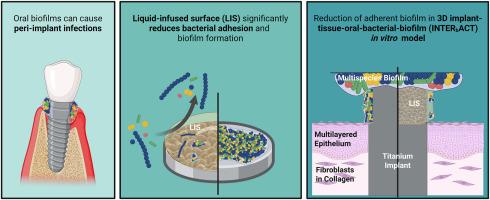生物相容性液体注入钛最大限度地减少口腔生物膜粘附在流动室和3D种植体-组织-生物膜体外模型
IF 18
1区 医学
Q1 ENGINEERING, BIOMEDICAL
引用次数: 0
摘要
生物医学植入物易受细菌定植,这可能导致具有挑战性的植入物相关感染。特别是,牙种植基台-持续暴露于口腔内的细菌-从抑制细菌生物膜发展的策略中获益良多。液体注入的钛表面表现出优异的生物膜驱避性,但迄今为止还没有用适合医疗器械批准的物质在模拟牙种植基台环境的条件下进行生物相容性分析。在这项研究中,对不同的医用级润滑剂涂覆在激光结构钛上进行了稳定性和拒水性筛选,结果表明涂覆硅油的未改性结构钛是最有前途的材料组合。在分析生物膜形成时,被涂膜表面显示出在静态条件下生长的口腔共生口腔链球菌生物膜以及在类似唾液流动条件下生长的口腔多物种生物膜的统计学显著减少。当涂层表面与3D种植体-组织-口腔-细菌-生物膜(INTERbACT)体外模型界面时,也观察到这种生物膜减少效应,该模型允许人体组织和口腔多物种生物膜在种植体界面直接相互作用。重要的是,这种生物膜的减少不是由于被涂膜表面的毒性,而很可能是由于细菌附着的抑制。此外,表面没有细胞毒性,不会改变邻近软组织或引起促炎细胞因子分泌升高。这些发现突出了生物相容性液体注入钛表面作为生物膜排斥种植基台修饰的前景,并为进一步有针对性的临床前研究提供了基础。本文章由计算机程序翻译,如有差异,请以英文原文为准。

Biocompatible liquid-infused titanium minimizes oral biofilm adhesion in flow chamber and 3D implant-tissue-biofilm in vitro models
Biomedical implants are susceptible to bacterial colonization, which can lead to challenging implant-associated infections. In particular, dental implant abutments – which are continuously exposed to bacteria within the oral cavity – stand to greatly benefit from strategies which inhibit the development of bacterial biofilms. Liquid-infused titanium surfaces have demonstrated excellent biofilm repellency, but to date have not been analyzed with substances suitable for medical device approval in terms of biocompatibility under conditions mimicking the environment of dental implant abutments. In this study, different medical-grade lubricants coated onto laser-structured titanium were screened for stability and water-repellency – with the results suggesting that unmodified structured titanium coated with silicone oil was the most promising combination of materials. When analyzing biofilm formation, the coated surfaces showed a statistically significant reduction in oral commensal Streptococcus oralis biofilms grown under static conditions as well as oral multispecies biofilms grown under salivation-resembling flow conditions. This biofilm-reducing effect was also observed when the coated surface interfaced with a 3D implant-tissue-oral-bacterial-biofilm (INTERbACT) in vitro model, which allows for the direct interaction of human tissue and oral multispecies biofilm at the implant interface. Importantly, this biofilm reduction was not due to toxicity of the coated surfaces, but is most likely attributable to inhibition of bacterial attachment. Additionally, the surfaces were not cytotoxic, without altering adjacent soft tissue or causing elevated pro-inflammatory cytokine secretion. These findings highlight the promise of biocompatible liquid-infused titanium surfaces as biofilm-repellent implant abutment modifications and provide the basis for further investigations in targeted pre-clinical studies.
求助全文
通过发布文献求助,成功后即可免费获取论文全文。
去求助
来源期刊

Bioactive Materials
Biochemistry, Genetics and Molecular Biology-Biotechnology
CiteScore
28.00
自引率
6.30%
发文量
436
审稿时长
20 days
期刊介绍:
Bioactive Materials is a peer-reviewed research publication that focuses on advancements in bioactive materials. The journal accepts research papers, reviews, and rapid communications in the field of next-generation biomaterials that interact with cells, tissues, and organs in various living organisms.
The primary goal of Bioactive Materials is to promote the science and engineering of biomaterials that exhibit adaptiveness to the biological environment. These materials are specifically designed to stimulate or direct appropriate cell and tissue responses or regulate interactions with microorganisms.
The journal covers a wide range of bioactive materials, including those that are engineered or designed in terms of their physical form (e.g. particulate, fiber), topology (e.g. porosity, surface roughness), or dimensions (ranging from macro to nano-scales). Contributions are sought from the following categories of bioactive materials:
Bioactive metals and alloys
Bioactive inorganics: ceramics, glasses, and carbon-based materials
Bioactive polymers and gels
Bioactive materials derived from natural sources
Bioactive composites
These materials find applications in human and veterinary medicine, such as implants, tissue engineering scaffolds, cell/drug/gene carriers, as well as imaging and sensing devices.
 求助内容:
求助内容: 应助结果提醒方式:
应助结果提醒方式:


